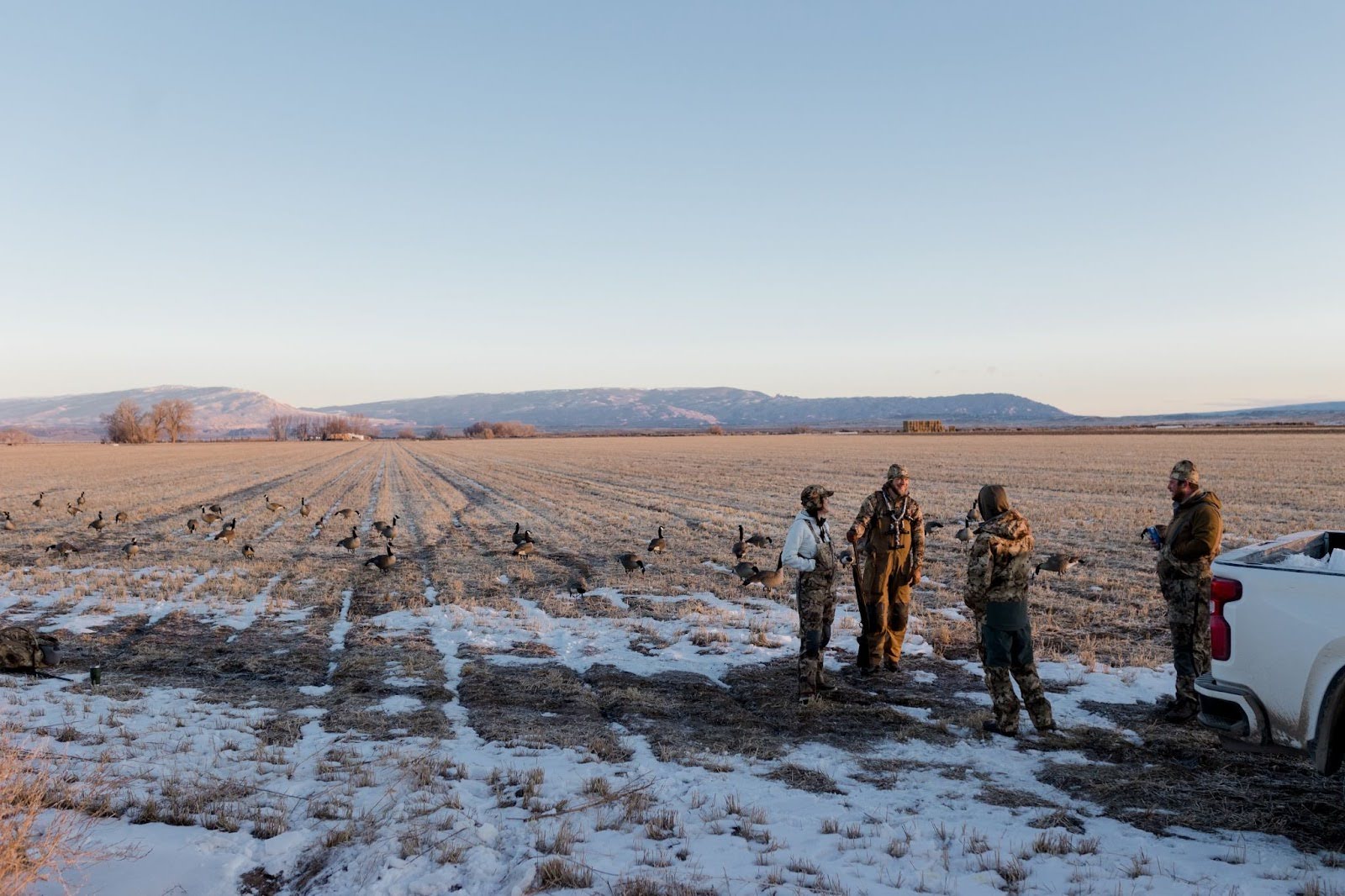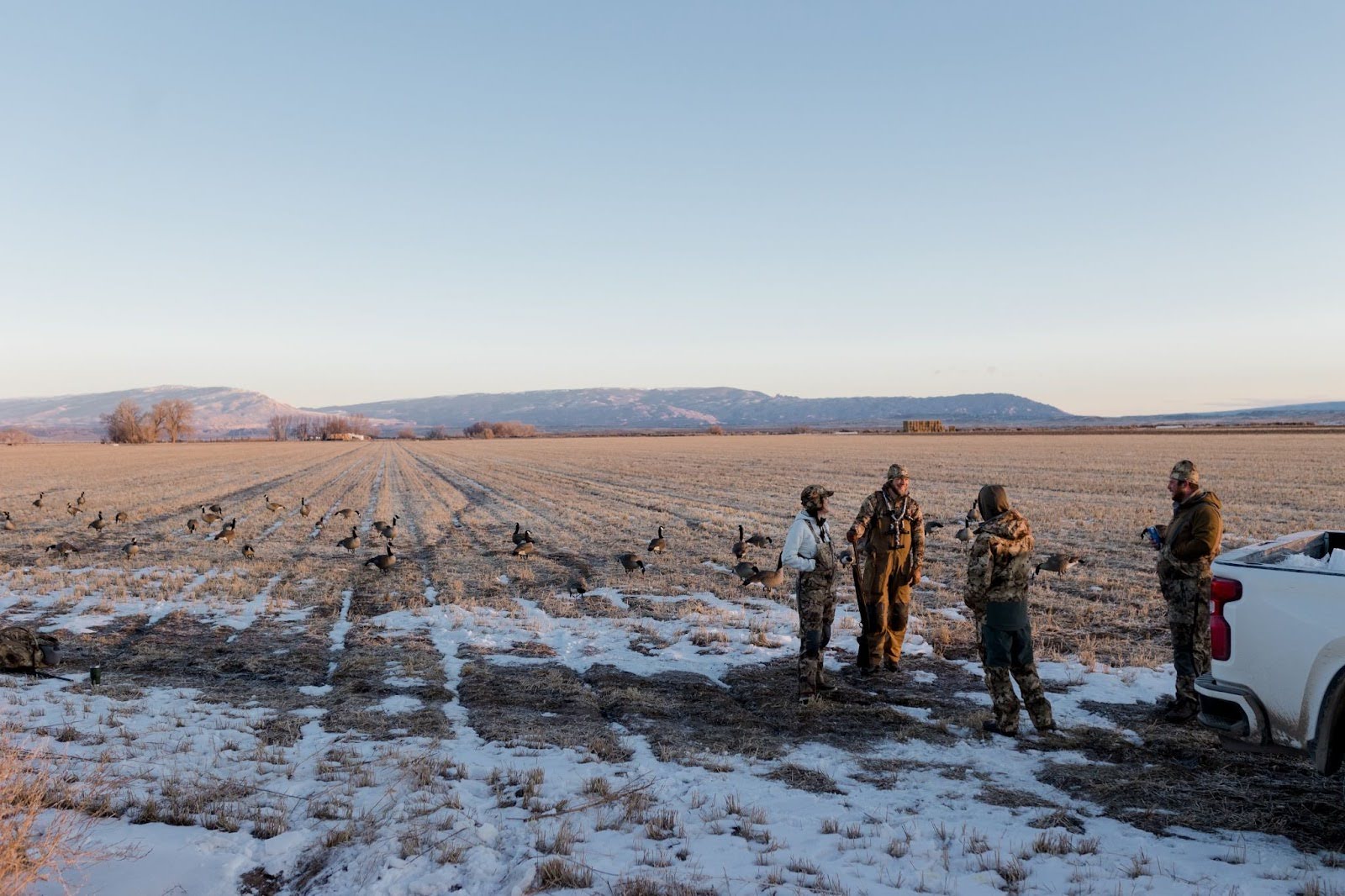Joe Fields | 7.31.2025
What to Wear Under Hunting Bibs
What to Wear Under Hunting Bibs
Long johns or a T-shirt? Sweatpants or jeans? If you’re new to hunting or looking to transition away from waders, you might not know what to wear under hunting bibs—the thick, insulated, overall-style pants that keep hunters dry and toasty on brisk days.
With so many options, it’s easy to fall prey to analysis paralysis, but we’re here to help. In this guide, we’re breaking down the types of clothing to wear under hunting bibs, tips for adjusting your layers, common mistakes to avoid, and more.
The Best Types of Clothing to Wear Under Hunting Bibs
Let’s start by covering all of your options—everything you could possibly wear under a set of bibs.
Base Layers for Varying Temperatures
Base layers are key pieces of hunting gear. While they’re available in a wide range of materials (e.g., nylon, wool, polyester), one material has changed the base layer game for good: merino wool.
Merino wool is:
Naturally porous – Merino absorbs moisture, wicking it away from the skin. Even if you expect to sweat on your walk or in the stand, merino will keep you warm and dry.
Warm when wet – Like most wools, merino gets warmer when wet. So, while it’s wicking moisture away, you’ll stay toasty.
Stink-resistant – Since it wicks away water so effectively, merino stays smelling fresh even after multiple wears. This is one of its most attractive features for hunters, especially those taking multiple-day trips or staying in primitive camps.
What kind of merino wool hunting clothes should you choose?
During warm weather, consider donning lightweight merino hunting base layers or merino blends. Blending merino with other insulating materials (like nylon) can improve durability.
On chilly days, opt for thicker merino half-zips or hoodies.
Insulation Layers
If you’re tackling a late-season whitetail hunt or venturing out into high altitudes, you’ll need to adopt a layered approach to hunting clothes. The same is true if you’re hitting the stand in moderately chilly or breezy weather—you won’t generate much body heat while sitting still. Even with the warmest hunting clothes, insulation layers are essential to providing the warmth needed when temperatures drop.
We know what you’re thinking: “Merino is supposed to keep me warm—why do I need more clothes?” In cold weather, merino and other base layers work best when accompanied by insulating layers: puffier, thicker, warmer garments. Base layers keep any body heat you generate close to your skin, but insulating layers help you generate that heat in the first place.
Depending on the weather, we recommend garments like:
Fleece pants
Down pants
Nylon jackets
Fleece pullovers
As you build your bib ensemble, prioritize:
Mobility – It’s hard to move when you feel like the Michelin man—save your puffiest garments for the coldest days.
Packability – In the same vein, your layers should be easy to stow in your backpack or tie around your waist if you get too warm on your walk.
Camo – Your outermost layer needs to be camo: fabric that blends into your surroundings and breaks up your silhouette. However, your inner layers don’t need to be camo unless you plan on ditching your jacket or bibs during the hunt.
Everyday Pants as an Alternative
Are we overcomplicating this? Do you really need two pairs of pants under your bibs?
In warm weather, probably not. In the warmest weather (during bow, early dove, or late spring turkey seasons, for instance), you might not even need bibs.
Whether you’re a central Florida hunter unlikely to see snow or you’re just trying to simplify your kit, don’t underestimate the power of standard, everyday pants. You can either:
Wear everyday pants under bibs – If it’s not that cold but you’re afraid of getting chilly in the tree stand, consider wearing regular ol’ khakis or jeans under your hunting bibs.
Wear just everyday pants – If summer weather hasn’t quite given way to the autumn chill yet, wearing nothing but regular pants (and your skivvies, of course) might be the move. This is especially true if you’re hunting in a ground blind or a box stand; since you’ll be covered up from the waist down, your target species won’t see your legs anyway.
At the end of the day, your kit needs to work for you—your weather, your target species, and your hunting style. While layering for hunting is a great strategy, it’s not a must in every case.
Tips for Adjusting Layers on the Go
You’re decked out in base layers, fleece, bibs, and a killer Windstopper jacket. But a quarter mile into your walk, you’re starting to feel the burn—what now?
Preparing for Temperature Fluctuations
The temperature can change on a dime during a hunt. Prepare for fluctuations by:
Using lightweight outerwear – If it’s a little too warm for a puffer but too cold for just a camo hoodie, don a lightweight outer layer and one insulating layer underneath. If you need to ditch your insulating layer, you won’t lose your concealment.
Opting for gear with vents – Quarter- and half-zips, snaps, and vents can all help you let a little chilly air in if your ensemble gets a little too hot.
Minimizing Sweat During Hikes
While merino is great at wicking moisture, this feature will only take you so far if you’re drenched in sweat. How you minimize perspiration will depend on your hunting style:
Stand/blind hunting – If you’re hunting in a stationary location, you’ll exert the most while walking to the stand. Consider wearing just base layers and a thin outer shell ( a windbreaker and lightweight bibs, for instance) on your walk. While you might be a little chilly when you get out of the truck, you’ll warm up as you get moving. Once you reach the stand, let any sweat evaporate, add an insulating layer from your hunting backpack, and start your hunt.
Stalking – If you’re trying to walk up a deer at the feeder or hunt along a drain in an ag field, consider the “be bold, go cold” approach: Opt for thinner or fewer layers and expect to stay warm as you move. Fore more, check out our blog to learn about the best camo for deer hunting.
Why Choosing the Right Layers Matters
Clearly, you have ample options when it comes to what to wear under bibs (if you choose to wear bibs at all). But choosing the right configuration of layers is critical to your safety and the success of your hunt.
Understanding the Role of Base Layers
Even in relatively warm scenarios, we strongly recommend wearing a base layer of some kind. No matter the material, your base layers should:
Wick moisture – Even on warmer hunts, a layer designed to keep sweat away from your body could actually help you stay cooler than you would if you had just worn a long-sleeved cotton t-shirt or a light jacket.
Retain warmth (if needed) – On colder hunts, base layers are a must. While insulating layers (hoodies and hunting fleece) will help you generate body heat, base layers will help you keep that heat close to you.
Meet your camo needs – If you’re wearing three layers, your base layers don’t necessarily need to be camo; you’re probably not going to take your jacket off if it’s snowing. If it’s warm, wearing camo base layers only could be a great option for moisture-wicking and blending in.
While we recommend choosing base layer materials that work for your weather, we don’t recommend cotton base layers—we’ll explain why below.
Balancing Comfort and Mobility
Choosing layers is all about finding the right balance—the perfect moisture-wicking combo that won’t leave you sweaty and red-faced by the time you get to the blind. However, you should also balance temperature comfort with mobility: your ability to move freely in your clothes.
Your mobility needs will depend on your hunt:
During wing shooting, you’ll need optimal upper body mobility—the ability to twist your torso and swing your arms.
During static rifle hunts, you’ll want to prioritize quick, decisive arm movements by preventing arm and shoulder restrictions.
While stalking, you’ll want to make sure both your arms and legs can move freely, as you’ll use both throughout the hunt.
Remember that your mobility needs will also change based on your weapon. A muzzleloader and a compound bow require completely different movements to operate; your ensemble should accommodate whatever moves you need to make to take a shot.
Common Mistakes to Avoid
As you build your bib kit, remember to:
Avoid over-layering – Hunting layering 101 is as follows: when in doubt, “go cold” and pack an extra layer or two in your backpack. Adding layers is much easier than taking them off (especially in tight box stands or on precarious ladders).
Skip cotton – While cotton might make sense for the hottest hunts of the year (think a muggy September bow hunt in the South), we highly recommend picking materials that are more breathable. Cotton holds moisture, which will only contribute to overheating in warm weather or increased cold in chilly weather.
Check fit and comfort – Make sure that you can comfortably wear one or more layers under your bibs—the same goes for your jacket. If you’re feeling like ten pounds of deer sausage in a five-pound bag in your bibs without your base layers or fleece pants underneath, consider sizing up for more versatility and comfort.
Choose SITKA Hunting Bibs and Hunting Clothes
As a hunter, you’re almost guaranteed to need a pair of bibs at some point. Even if you’re only planning to hunt spring turkeys or early whitetail, you never know when your buddy is going to invite you to a new camp in a cold climate—when bibs will certainly be on the menu.
Be prepared for every hunt with SITKA: the home of low-bulk, quiet, and top-quality gear for the discerning hunter. Not sure where to start? Check out the SITKA System Builder for an all-in-one, custom guide to choosing your hunting kit.
From waterfowl to whitetail, quail to caribou, and snipe to squirrels, hunt Sitka.
Sources
Forbes. The Technologies Giving Wool a Fresh Approach in Performance Gear.


